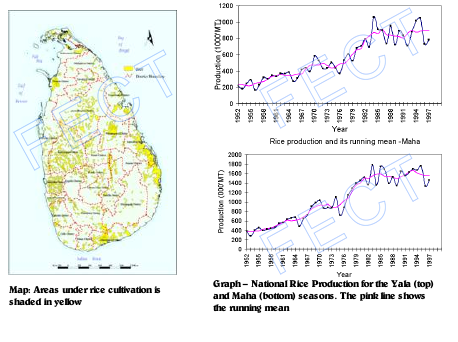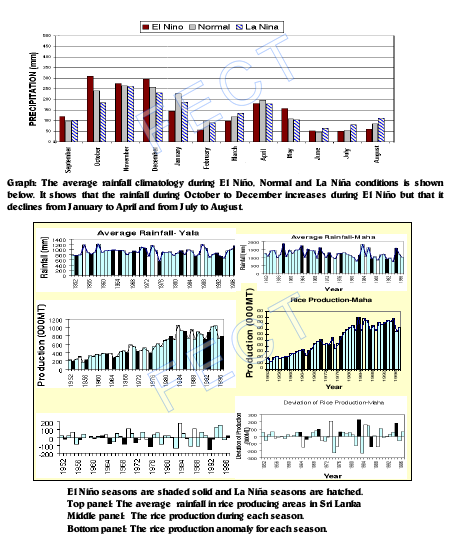Rice
 Rice is the staple food in Sri Lanka and it is cultivated by farmers on a small-scale in the rural regions. Rice production is acutely dependent on rainfall. The principal cultivation season, known as "Maha", is from October to March. During this season, there is usually enough water to sustain the cultivation of all rice fields. The subsidiary cultivation season, known as "Yala", is from April to September. Usually there is only enough water for cultivating half the land extent.
Rice is the staple food in Sri Lanka and it is cultivated by farmers on a small-scale in the rural regions. Rice production is acutely dependent on rainfall. The principal cultivation season, known as "Maha", is from October to March. During this season, there is usually enough water to sustain the cultivation of all rice fields. The subsidiary cultivation season, known as "Yala", is from April to September. Usually there is only enough water for cultivating half the land extent.
There has been a steady increase in rice production in Sri Lanka from 1940 to 1990. This rise has been attributed to increased area under cultivation, increased irrigation, improved seed varieties, increased fertilizer application and higher purchase prices for rice. However, rainfall variations affects the inter-annual variability of rice production as distinguished from its long-term trends. El Niño and La Niña are states of unusual warm and cool tropical eastern Pacific ocean surfaces respectively.
Two decades ago, it was discovered that the rainfall of Sri Lanka is
Programs
Current Projects
- PEER-Water Adaptation
- AgMIP-Agricultural Modeling
- MDP-Sustainability Education
- Drought Risk
- Summary
- Water Resources
- Human-Elephant-Conflict
- Rice
- Plantations
- Disaster Management
- Malaria and Dengue
- CCAFS
Past Projects
Advocacy
Outreach
Tsunamiscience
News
Quick Links
Climate Predictions
Climate Monitoring
Weather Monitoring
Advisories
Connect with us
affected by ENSO. Our work has confirmed that link and also uncovered a link between ENSO, rainfall and the production of rice. This provides a basis for using ENSO based predictions for agricultural policy formulation and management.


Summary
During the last 45 years, the Maha rainfall and rice production has dropped 10 out of the 15 years with El Niño and in 7 out of the 10 years with La Niña conditions. During the same period, the Yala rainfall and rice production have dropped in 8 and 10 years respectively out of 14 with El Niño and 6 years out of 8 with La Niña.
